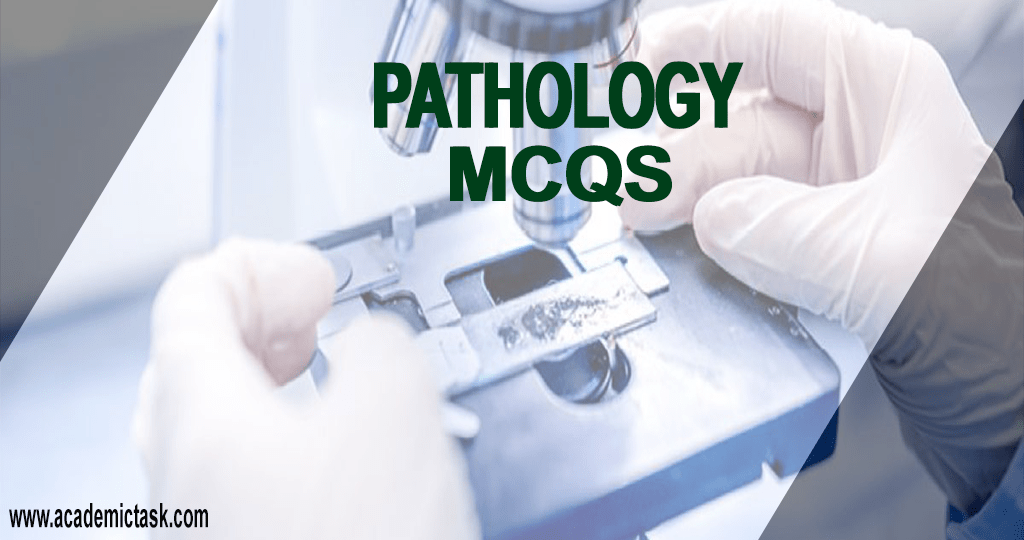
Pathology is a branch of medical science that involves the study and diagnosis of disease through the examination of surgically removed organs, tissues (biopsy samples), bodily fluids, and in some cases the whole body (autopsy). Academic tasks provide 3000+ basic and advanced levels of pathology MCQ with answers. In this section, we focus on all areas of MCQs on pathology subject and cover all important topics of pathology like Primary Cardiovascular, Primary Cellular, Primary Endocrine And Renal, Primary Cellular Pathology, Cell Injury, General Pathology, Organ System Pathology, Atherosclerosis-Thrombosis, Embryology, Neoplasia, Nutrition, Transfusion Medicine, Coagulation – and much more. All these topics are chosen from trusted and best reference books on biochemistry. These biochemistry MCQs are also helpful for the preparation of interviews, entrance examinations, other competitive examinations, and certifications for all Experienced, Freshers and Students. Also, check MCQs on Oral Histology here.
Pathology MCQS for Test Preparation
| S.NO | Pathology MCQS | S.NO | Pathology MCQS |
|---|---|---|---|
| 1 | Cell In Health And Disease | 2 | Fluid And Heamodynamic Disorders |
| 3 | Healing | 4 | Systemic Pathology & Miscellaneous |
| 5 | Diseases of Blood And Lymphnodes | 6 | Growth Disorders And Neoplasia |
| 7 | Inflammation, Immunity And Hypersensitivity | 8 |
1. Which of the following is correct ?
A. Pyknosis – shrinkage of nucleus
B. Karyolysis – Dissolution of nucleus
C. Karyorrhexis – fragmentation of nucleus
D. All of the above
2. Which of the following statement is _____________?
A. Low density lipoproteins has maximum association with atherosclerosis
B. High density lipoproteins have protective role in atherosclerosis
C. Poly unsaturated fats lowers plasma cholesterol levels
D. HDL contains the highest cholesterol content
3. Which of the following statements is true?
A. Arterial thrombi produces ischemia and infarction where as cardiac and venous thrombi cause embolism
B. Arterial thrombi to be white and non occlusive (mural) where as venous thrombi are red and occlusive
C. Venous thrombi are soft, red and gelatinous where as arterial thrombi are firm and white
D. All of the above
4. Which of the following is not an action of epinephrine when administered intravenously in a high dose ?
A. Increased liver glycogenolysis
B. Causes broachiolar constriction
C. Evokes extrasystoles in the heart
D. Produces restlessness and anxiety
5. The antidote for heparin is______________?
A. Penicillinase
B. Protamine sulphate
C. Pryosulphate
D. Potassium sulphate
6. An excess of which of the following hormones may be associated with increased sensitivity to epinephrine ?
A. Testosterone
B. Parathyroid
C. Insulin
D. Thyroid
7. Pilocarpine_______________?
A. Lowers the intraocular pressure in glaucoma
B. Cleaved by acetylcholinesterase
C. Inhibits sweat and lacrimation
D. Causes tachycardia
8. The drug which is used to treat laryngospasm is_______________?
A. Atropine
B. Diazepam
C. Neostigmine
D. Succinylcholine
9. The drug of choice in the management of life threatening allergic reaction is______________?
A. Corticosteroids
B. Antihistamines
C. Adrenalin
D. Diazepam
10. The following drugs are avoided with warfarin ______________?
A. Antacids
B. Benzodiazepine
C. Nsaid’s like Ibuprofen
D. Codeine, dihydrocodeine, paracetmol
